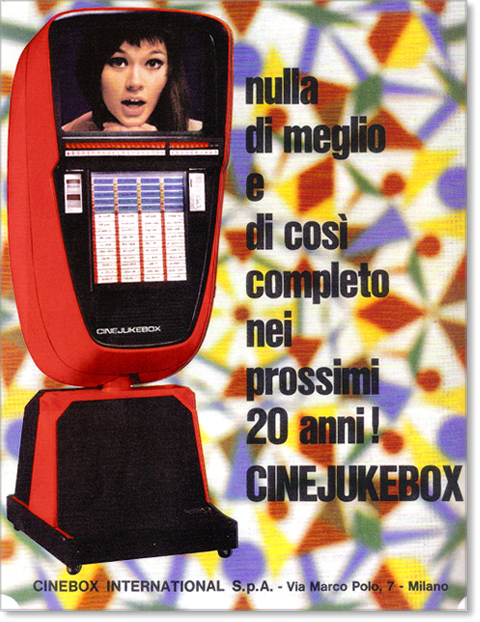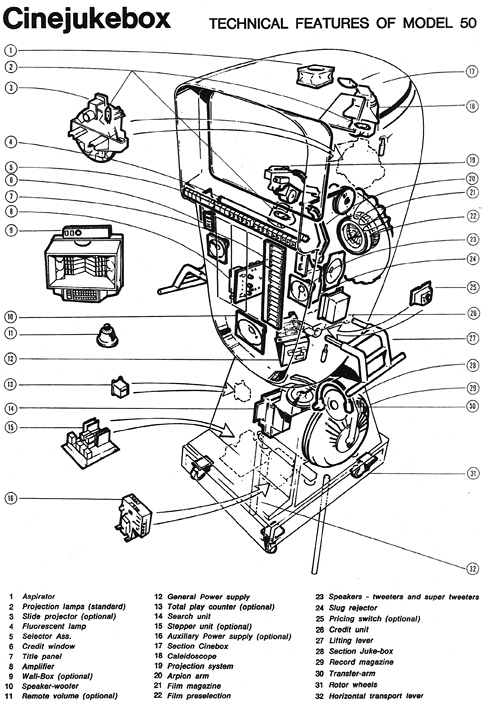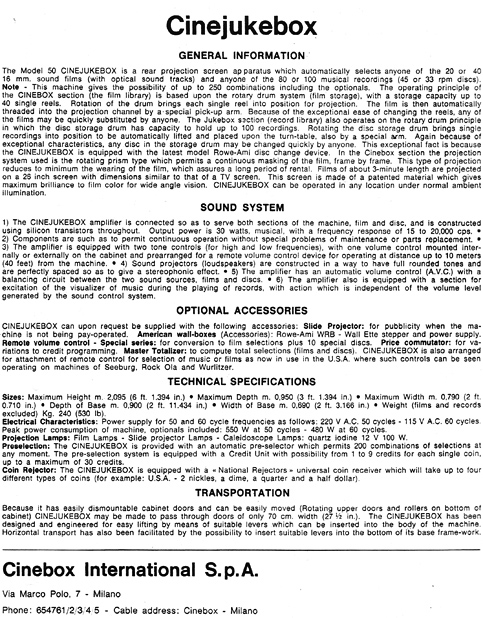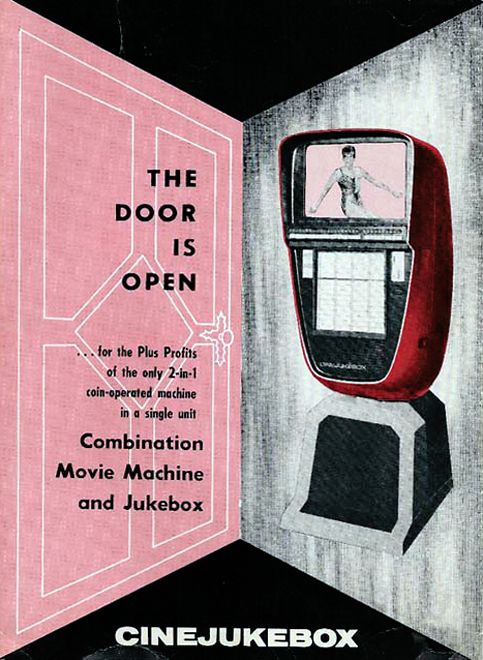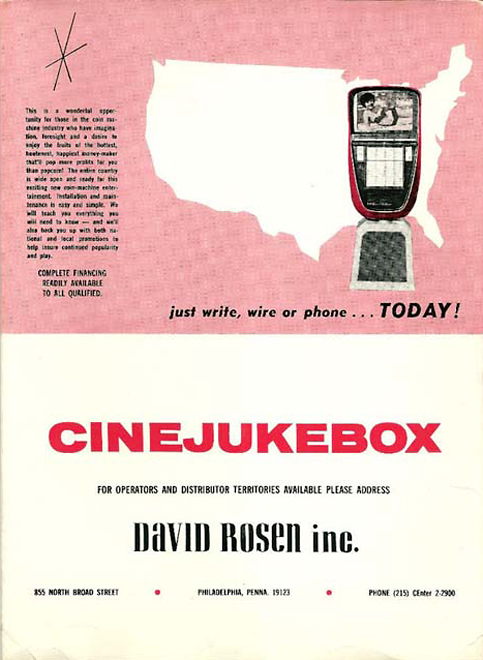Goodbye Clem Sacco, brilliant and crazy ancestor of Italian rock
CLEM SACCO, THE FORERUNNER OF TRANSGRESSIVE SONGS, PASSED AWAY ON THE NIGHT OF MARCH 9: ON MAY 19 HE WOULD HAVE TURNED 91. HIS SONGS SUCH AS “OH MAMA VOGLIO L’UOVO ALLA COQUE” AND “BACIAMI LA VENA VARICOSA”, ALWAYS CENSORED BY RAI, HAVE TAUGHT MANY GENERATIONS OF ITALIAN ROCKERS.
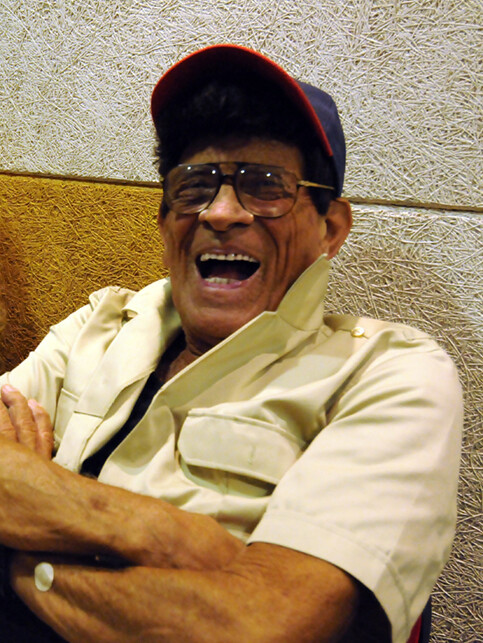
“Baciami la vena varicosa” (Kiss my varicose vein), “Succhiami il dente del giudizio” (Suck my wisdom tooth), “Strappami il pelo dal neo” (Pluck the hair out of my mole), “Vampira vampira vampira cha cha” (Vampire vampire vampire cha cha). These are not lyrics of songs by the Elio of the taut stories, or Freak Antoni of the Skiantos. Neither do they have anything to do with the group called Squallor. They are just the titles of songs written and recorded many years before, in the early sixties, by Clem Sacco, the most audacious, unhinged, wild and boisterous Italian pioneer of irreverent rebel rock ‘n’ roll. He lived a fast reckless daredevil life, somewhat along the lines of Blasco (an often used nickname of the very famous Italian Rock singer Vasco Rossi) and the as free as a bird Steve McQueen whom we can say was almost as free spirited as the great Voltaire. Clem was born in Cairo 1933 of Italian parents. His father was Sicilian and his mother was Piedmontese. They had emigrated to Northern Africa in search of a better life and like many other Italian immigrants, were hard workers. Just like the parents of Clem’s school mate Yolanda Gigliotti who like many schoolgirls dreamt of becoming film stars, while Clem dreamt of becoming a an opera singer.
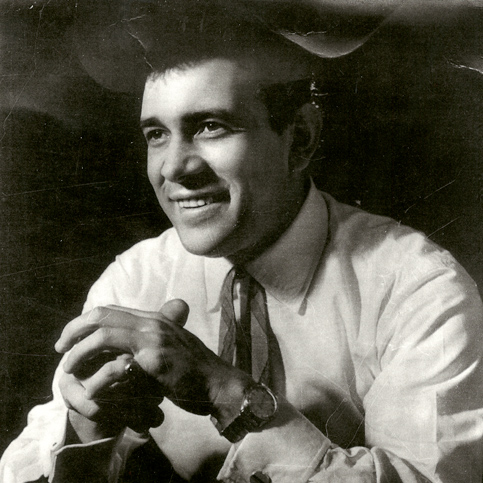
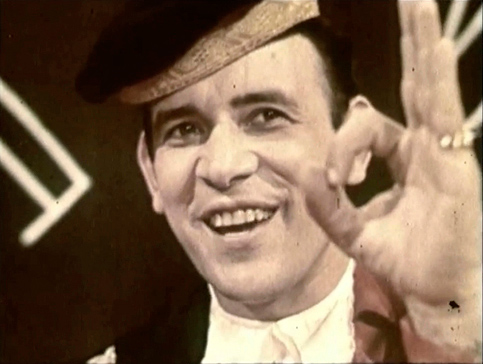
Both Clem Sacco’s and Yolanda Gigliotti’s fathers ended up in prison. Those were hard days of misery, trouble and strife and the end of all illusions. After the war the young ones left for Europe. Yolanda went to Paris, France where she became the famous singer Dalidà and Clem went to Milan, Italy to study singing. To pay his way through the Civic School of Classical Opera Music, Clem worked in the main Fruit and Vegetables Market mainly unloading crates of apples and tomatoes and in his spare time he taught Body Building and physical fitness training in a couple of gymnasiums. In that period Italy was producing many mythological sword and sandal films featuring Maciste and Hercules. When Clem was in Egypt, he became proficient in the decathlon and consequentially had a highly developed chest and rock hard muscles like Steve Reeves, but alas, his mind was set in another direction; his hero was Enrico Caruso. He graduated from the school of music and went for an audition in Mantova where they were looking for a young baritone for the opera season. Clem came second in the auditions and was so upset that he swore to himself that he would never dress up in the Rigoletto costumes. If he wanted to eat twice a day then he would have to make a living in modern light music such as pop or rock and roll. He thought that it was easier to make money in Night Clubs and Dance Halls than it is in classical theatres such as La Scala. Little did he know! It is 1955 and from far away America we hear the first bouncing notes and jumpy rhythms of new songs with groovy sounds: A swinging singing guitar thumper with a kiss curl that reminds us of a petit and lovable Italian vaudeville style comedian named Erminio Macario. Here comes the great Bill Haley, the kingpin of the newborn world conquering Rock ‘n’ Roll that makes even the chairs dance, reel and roll with “Rock around the clock”. Milan, like the rest of the world jumped on the Rock ‘n’ Roll bandwagon. Overnight newborn rockers and rollers became improvised musicians who gyrated around the Arcade of central Milan exchanging hastily written sheet music of songs high-jacked from the juke-boxes and tinny home-made mono recordings on spools of primordial magnetic recording tape. Within a couple of years a whole new harvest of Rebel Rousers sprouted up imitating and styling themselves as puffed up pseudo Marlon Brando or James Dean, their legendary heroes.
Clem Sacco “L’angolino dell’amore”(The little corner of love) Cinebox, 1961.
The pioneers of Italian rock were Giuseppe Negroni, Franco Vicini, Johnny Baldini, Silvano Silvi, Big Guidano (later; Guidone), Fausto Denis (later; Fausto Leali), Jean Luck (later; Luciano Vieri), Brunetta, Ghigo and (last but not least) Clem Sacco. At the end of the decade the late arrival of those who were destined to become famous: Baby Gate (later; Mina), Adriano Celentano, Giorgio Gaber. During their periodical gatherings, these rock ‘n’ roll enthusiasts jumped rocked, rolled and bounced between the Ice Rink stadium and the Smeraldo Theater. In these happy happenings there were two foreigners; Colin Hicks (the younger brother of the 1950’s King of British Rock ‘n’ Roll Sir Tommy Steel) with his accompanying group The Cabin Boys who were often seen and heard at the Santa Tecla music bar. The other personality Little Tony (and his Brothers) for the Italians is theoretically a foreigner because he was born in and is, a citizen of the tiny castle dominated fairy tale Republic of San Marino, which is a medieval jewel completely landlocked within the Italian mainland.
Clem Sacco with his Califfi (The Caliphs) “Oh mama, voglio l’uovo à la còque” (Oh mama, I want a soft boiler egg) Cinebox, 1962.
Clem Sacco and Ghigo do seem to have more artistic drive and talent than the others: they are the only ones that write and sing their own songs. Ghigo wrote and sang “Coccinella” (Ladybird (Ladybug)) and managed to appear on the very famous and very popular television music show “Il Musichiere” featuring Mario Riva but after that show he fell prey to the fangs of the Italian censors who firmly rejected his other songs as misleading. It was as if the Italian Board of Censors had rubber-stamped on his forehead with the word Banned: every single song he recorded seemed to specifically to offend everybody “Enea con il neo” (Enea and his mole), “Il deficiente” (The deficient idiot), “Spacca, rompi, spingi” (Smash, break, push) without even mentioning “varicose veins” or “uova alla coque” (Soft boiled eggs). All these song seemed to be an ignominious resounding slap in the face of narrow minded prudery. But, on the other hand, what must one think of someone who wails, screams and prances all over the stage in leopard-skin underpants.
Clem Sacco “The deficient” (The nutcase) Cinebox, 1962.
Clem Sacco recalled that, “The day after that first show at the Smeraldo Theater I went to the Durium record company thinking that I would get the Red Carpet treatment from the president Mr Krikor Mintigian due to the fact that all Milan was talking about my performance of ‘soft boiled egg’ in my leopard-skin underpants”. Instead I was shouted down to the tune of “You have dragged us though the mud with your disgusting and outrageous performance! Get out of my office and don’t ever you dare to set foot here again!” Thus was born yet another embargo! Not only had the Italian Television company had banned him but now also the record companies and the music publishers. But he stubbornly pushed on: in 1961 Clem was the lead voice of ‘I Ribelli’ who were the Clan’s backing group of Celentano. He had to stand in for Adriano Celentano who had been called up for national service in the Italian army. In agreement with Celentano the posters announced “The Clan of Celentano presents ‘I Ribelli’ with the vocalist Clem Sacco. The saxophone player of ‘I Ribelli’ Natale Massara, states that “Clem was the only person around that could credibly substitute the boss Adriano Celentano. He sang the whole Celentano repertoire and also added some of his own hilarious and explosive songs. The audiences loved it! He was a born natural freaky entertainer. When Celentano was dimobbed from the army he recorded the song “Basta” (That’s enough) and Clem formed another group called ‘I Califfi’. The members were Gino Santercole (who is the nephew of Celentano) on the guitar, Dino Pasquadibisceglie (who to this day still works with Celentano) and on the drums Enrico Maria Papes who later became famous in Italy with his own group ‘I Giganti’ in which he was the percussionist and was renowned for his deep bass voice.
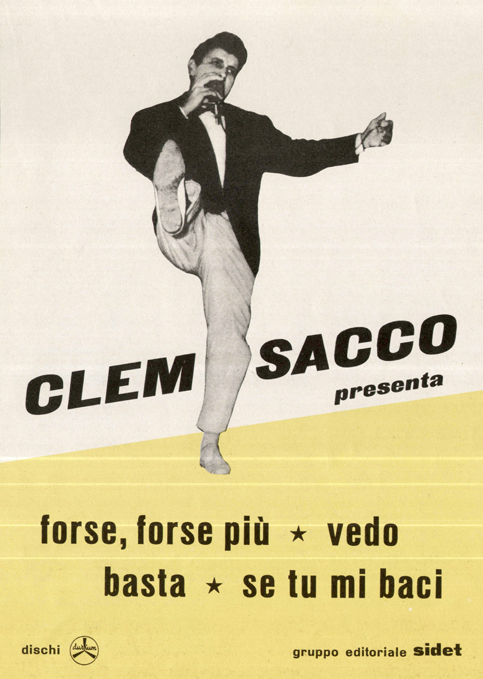
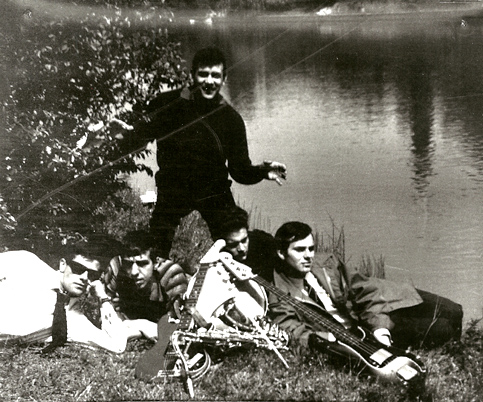
Clem Sacco and his Califfi.
A firm believer in Clem was Angelo Bottani, the right hand man of the president of the famous Milanese football club “Inter”. Mr Bottani, a versatile financial operator, embarked upon the Cinebox enterprise. The Cinebox was the new video juke-box that enchanted the younger generation in the early sixties that had signed up Clem to sing in 5 videos: Today they are considered landmarks in music video history. Also the film director Carlo Infascelli hired Clem to play a nutty prisoner in his 1963 film “Canzoni, bulli e pupe”. But the Italian board of censors clamped down their ban on the Italian Radio and Television and the (red card) the heavy hand of the powerful president of Duriam records Mr Mintangian did the rest by effectively boycotting Clem out of the music business. Once again Clem did not give up! He continued to write many irreverent cranky trashy songs with way out words and if he wanted them on the market he was obliged to creat his own record company and label and he also had to distribute them himself almost hand to hand.
Clem Sacco “Chunga Twist” Cinebox, 1962.
The Orchestra Director Vinci Tempera recalls that; “In Milan, right in front of the shop-front of the music publishers, distributors and record company ‘Messaggerie Musicali’ you could always find the permanently parked Camper of Clem Sacco that was his own all in one mobile supermarket. He used to sell to anyone and everyone his own records plus a large variety of miscellaneous wares that ranged from nail-clippers to soft porn playing cards. When I was young I sometimes played the piano in his group and I came to realize his natural talent and I found it absurd, demeaning and mortifying that he should be in such a situation. Not withstanding he seemed to live a good life. He was always happy go lucky, on the ball and full of Gung-Ho and gumption. In one song a line was “Papà, I want a quarter of Lion meat”. It would seem that his father had effectively given him the lion-meat! Once again, only a few days ago, I met Clem and although he wears glasses and has a few more lines than he used to have, he is still a strong, very bouncy and spirited person. He still has the same booming deep and forceful lion’s voice that he had forty years ago.
Clem Sacco “Vino, Chitarra e luna” (Wine, guitar and moon) Cinebox, 1962.
In order to survive Clem has had to invent a thousand trades (jobs): he posed as a model for the sculptor Francesco Messina at the Brera Art Academy in Milan, a representative, a door to door encyclopedia salesman and a few and far between gigs (one nighters) that he manages to wrangle out of tight-fisted agents. Clem reconted us that “One agent said: there is nothing for you…..unless…no!….I don’t dare to ask you. It is a job (booking) that everyone (every artist) has refused, even those who are a little strange. I told him that I would have to accept any type of booking! So he told me that it was a contract for six months as an attraction in the Alexander Bar whose public was exclusively homosexual. I did not ask him to repeat the offer because I accepted it on the spot. I went and bought an outlandish long haired wig and promptly changed my name for a six month stint as a hairy legged Clementina Gay. I started singing, raving, ranting ‘n’ rockin’ ‘n’ a rollin’ dressed in drag. With a wife and kids to keep, it was like Pennies from heaven.

As time passed, his music career slowly wound down until it became his alterative pastime pleasure job. For many years he has been living in Tenerife in the Canary Islands and he has sung every type of song from classical to Folk to Rock ‘n’ Roll in every nook and cranny that has an audience, night-clubs, restaurants, bars, folk-clubs beach parties. He has sung, shake, rattle and rolled, all over the Canary Islands a hundred times over and they still want more.
He came back to do a few shows in Italy in 2006. He was invited to Musicultura in Macerata. A rolling river and waterfall of applause hailed the TNT grandfather who was loudly appreciated by the younger generation: Three young groups have recorded some of his songs: Gaby e i Batmacumba (see the Modena City Ramblers), the Serf and the Cabona Abusers.
Clem Sacco was a guest of honor on the 18th of July at the Porretta Soul Festival singing “Vampira Cha Cha (Baciami la Vena Varicosa)” (Vampire Cha Cha (Kiss my varicose vein) and the accompanying group was the Memphis All Star Rhythm & Blues Band.
In January of 2007 Clem Sacco and the famous Italian Radio and Television personality Renzo Arbore, presented the ‘RAI Television Channel 2’ documentary program ‘Tg2 Dossier Storie’ which was dedicated to 50 years of Italian Rock. In the same period Gene Gnocchi, who hosted the RAI Channel 2 television program, “Grande Notte” awarded Clem Sacco a prize of honor for being “The most irreverent and transgressive artist in the history of Italian Rock”.
Clem also appeared in two Rai 1 TV programs: in ‘I Migliori Anni’ in 2009 and in ‘Ciak Si Canta’ in 2010 which was hosted by the famous Italian singer and Master of Ceremonies Pupo. During this show Clem’s new music video entitled ‘Baciami La Vena Varicosa’ (Kiss My Varicose Vein) was shown. The video was screen-played and directed by Asia Argento who is a self-declared ‘long-time passionate and ardent fan’ of Clem Sacco. Asia Argento is the actress and film director who is considered ‘The Queen of horror”. She is the daughter of the even more famous Dripping Blood King of Horror film director Dario Argento. When asked if she would do a video for the television program ‘Ciak Si Canta’ she replied “NO! Never!”. When she was told it would be with the Italian ‘Irreverent King of Nutty Rock and Roll Clem Sacco’ she excitedly exclaimed “I will gladly do it free of charge!”
Clem Sacco in the music video “Vampira Cha Cha (Baciami la vena varicosa)” (Vampire Cha Cha (Kiss my varicose vein) screen-played and directed by the famous actress/film director Asia Argento and produced together with her companion the Film Director Michele Civetta especially for the Rai 1 program “Ciak Si Canta” (9th April 2010).
His last Italian performance dates back to August 2014, on the stage of the Fonclea Riverside in Rome: a challenge between Rock and Beat, Clem Sacco against Mal of the Primitives, both accompanied by a group of old rock glories.
Vince Tempera says that “of today everybody tends to pump up songs by adding irrelevant salt and pepper and persimmon fruits. The market seems to accept obscenity and blesses every type of provocation but categorically refuses irreverent disrespectful transgression. Clem Sacco has been undoubtedly the first utterly courageous transgressive Italian Rock Artist. He was and still is authentic: he paid the high price of his audacity with the total censorship and disapproval by short sighted moralists and reactionaries. All throughout his life we have never heard him moaning, shouting, raving or letting off verbal steam on street corners. In public, he has never said a word against his detractors. You could say he seemed to democratically respect their views.”
Summing up, we can here redeem the great Clem Sacco, who was the Godfather and King of the Bizarre, Bold, Irreverent, Jumping, Nervous, Crazy Italian Rock.
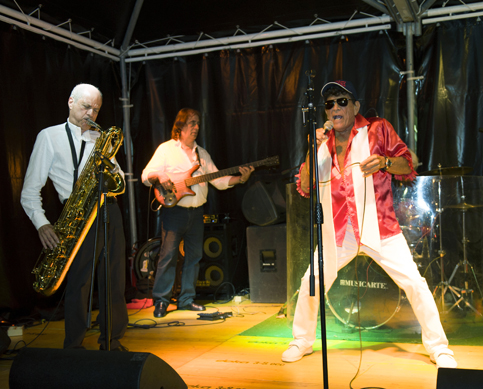
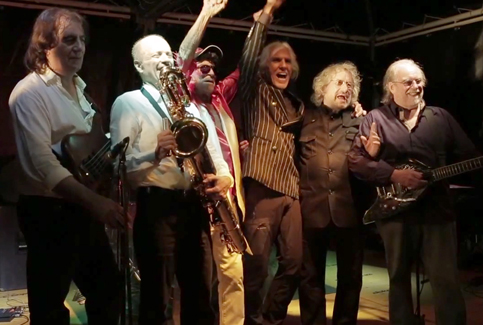
Clem Sacco live at Fonclea Riverside, August 1 2014. Piano Detto Mariano, drum Gianni Dall’Aglio, guitar Johnny Charlton, bass Gianni Colaiacomo, sax Michele Bovi.

“How I met Clem Sacco”
Narrated by Johnny Charlton, the ex lead guitarist of The Rokes, the most popular and famous English group in Italy during the nineteen sixties.
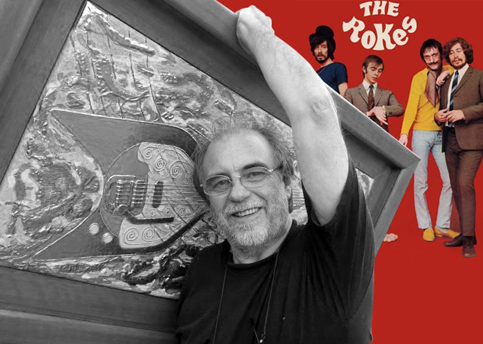
Johnny Charlton.
I had the fortune to meet Clem Sacco during the Rai uno Italian Television show Ciak si Canta (Clapper board and sing) in 2010. I found him meditating contentedly in an armchair in the completely empty and silent TV studio. I recognized him, broke the spell and presented myself. He politely asked me; “Where are the dressing rooms?”
While a young lady from the organization was welcoming him and talking about the program he was offered a glass of champagne. Without thinking twice, he deftly extracted his dentures, put them in a glass and started gleefully sipping the champagne from his challis and after each mouthful happily and noisily sucked his gums. Only when he noticed the wide eyed shocked expression upon the ladies face did he exclaim; “Champagne tastes much better without false teeth! One can actually taste and play around with the bubbles!”
Clem is an easy to get on with, nice and pleasant, happy go lucky smiling person. His attire is everyday and certainly not eccentric in any way. He lives in Tenerife in the Canary Islands and is a person who lives life to the fullest. He is still an uncontrollably free as the wind beachcomber who has many interests and a fine eye for beautiful sunsets, sea and sand. But, when he hears a bit of rock ‘n’ roll and feels an audience, he lights up like a Christmas tree and becomes the bouncy, lovable, cranky, irreverent jitterbugging life and soul of the party. When I think about it, I do believe that a very big chunk of humanity would like to be just like him.

